Space
Solar system; Formation, planets, wonders and everything you need to know
Published
11 months agoon


Solar system; Formation, planets, wonders and everything you need to know
The solar system is one of the billions of star systems in the Milky Way galaxy, which consists of the average central star of the Sun. The order of placement of the planets in this system from the nearest mass to the sun are Mercury, Venus, Earth, Mars, Jupiter, Saturn, Uranus, Neptune, and possibly the ninth planet.
The solar system starts from the sun continues to the Kuiper belt and finally reaches the boundary of the Heliopass. According to scientists, the edge of the solar system is approximately 15 billion kilometers away from the sun. On the other side of the Heliopass, there is a huge oval-shaped cloud called the Oort cloud, which surrounds our solar system.
Table of Contents
- What is the solar system?
- The origin of the solar system
- Size and distance in the solar system
- Sun
- The planets of the solar system
- What is a planet?
- Mercury
- Venus
- planet Earth
- planet mars
- Jupiter
- Saturn
- Uranus
- The planet Neptune
- asteroid belt
- Kuiper belt
- Pluto
- The ninth planet
- edge of the solar system
- The largest planets in the solar system
- Discoveries and travels of the solar system
- Photos of the solar system
- Conclusion
What is the solar system?
The solar system is a collection of planets, moons, asteroids, comets, and gas and dust that revolve around the Sun star. This system consists of rocky planets including Mercury, Venus, Earth, and Mars, gas giants including Jupiter and Saturn, and ice giants including Uranus and Neptune.
Between Mars and Jupiter, there is a set of asteroids known as the Asteroid Belt, and on the other side of Neptune, a set of small icy bodies known as the Kuiper Belt revolve around the Sun. Objects such as the dwarf planet Pluto are also considered part of the Kuiper belt.
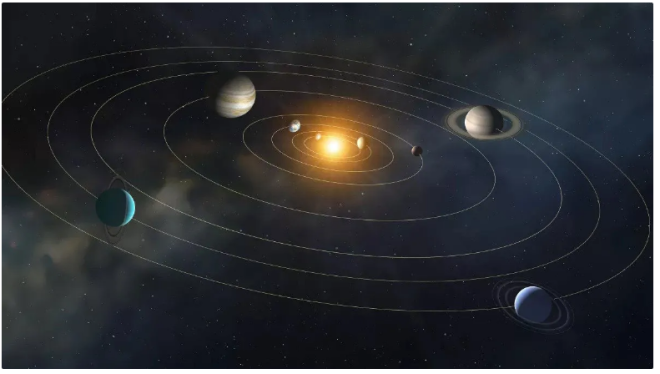

The origin of the solar system
About 4.6 billion years ago, a dark cloud of gas and dust underwent a gravitational collapse. This cloud compressed and turned into a rotating disk known as the solar nebula. The heat and pressure were eventually so great that the hydrogen atoms fused together to form helium. Nuclear interactions released large amounts of energy and the Sun was formed.
The Sun collected approximately 99% of the material in the solar nebula, and the rest of the material formed similar clumps inside the rotating disk. Some of these materials reached enough mass and gravity to form globular masses or planets, dwarf planets, and moons. The remaining fragments formed meteorites, comets, and other moons that make up the solar system.
Meteorites, or celestial rocks that fell to Earth, helped scientists estimate the age of the solar system. Some of these small fragments originated from moons or planets that can provide fascinating scientific information about the chemical properties and history of their parent matter. Some others were circulating in the solar system from the very beginning and before the formation of planets. The Allende meteorite, which fell to Earth in 1969, is the best-known meteorite with an age of 4.55 billion years.
According to scientists, the solar system was created during the explosion of a nearby star or the supernova process . According to this theory, the explosion caused shock waves to be sent into space and these waves compressed the solar nebula and finally led to its collapse. The supernova likely drove material into the nebula.


The stages of the formation of the solar system
Size and distance in the solar system
The solar system is so big that it is almost impossible to imagine its size using units like kilometers. The distance from the Earth to the Sun is approximately 150 million kilometers, but the distance from the Sun to the farthest planet in the solar system, Neptune, is 4.5 billion kilometers. Now compare this distance with the average distance that a healthy person can walk non-stop in one day (32 km) or the distance to the International Space Station (400 km).
The best way to estimate the size of the solar system is to create a scale model that shows the distance of the planets from the sun. Astronomers use the distance between the Earth and the Sun (150 million kilometers) as a unit of measurement known as the astronomical unit. Therefore, 150 million kilometers is equal to one astronomical unit, or AU for short.
Thus, the distance between Mercury and the Sun (0.43 AU), Venus is 0.7 AU, Earth is 1 AU and Mars is 1.5 AU. Then we reach the asteroid belt, which is 2.8 AU away from the Sun. The gas giants Jupiter and Saturn are 5.2 and 9.5 AU from the Sun, respectively, and the ice giants Uranus and Neptune are 19.8 and 30 AU, respectively.
The Kuiper Belt is 50 AU away from the Sun and finally, the border of the Solar System or Heliopass is 123 AU away from the Sun.
Read More: The International Space Station
Sun


An artist’s rendering of the Parker probe exploring the Sun
The sun is at the center of the solar system and constitutes approximately 99.8% of the mass of its system. The sun provides the necessary energy for life on Earth. This composite yellow dwarf star consists of 91% hydrogen and 8.9% helium. The Sun is relatively small compared to other stars and is one of hundreds of billions of stars in the Milky Way galaxy.
The planets of the solar system
The four inner planets of the solar system, Mercury, Venus, Earth, and Mars, are classified as terrestrial planets or rocky worlds due to their rocky surface.
The four outer worlds of the solar system, namely Jupiter, Saturn, Uranus, and Neptune, are called Jupiter-like planets due to their larger size than the rocky planets. Most of these planets are made up of gases such as hydrogen and helium, although some planetologists believe that some of these planets have solid cores.
The planets Jupiter and Saturn are called gas giants, while Uranus and Neptune, the two outermost worlds of the solar system, are classified as ice giants because they are composed of elements heavier than hydrogen and helium, such as oxygen, carbon, nitrogen, and sulfur, and have a thick mantle. They have methane, ammonia, and frozen water.
What is a planet?But before introducing the planets of the solar system, it is necessary to get acquainted with the definition of a planet. According to the standard definition, a planet is a mass of sufficient size that revolves around the Sun and itself. But it is not big enough to undergo nuclear fusion like a star. It has also cleared its vicinity of a large number of other objects.
The exact definition mentioned above shows what should be included in the category of planets and what should not be included in this group. However, the problem arose when astronomers discovered a large number of planet-like bodies in the solar system. For example, Pluto was one of the objects that could not meet all the above conditions and was classified as a dwarf planet.


Most of the gaseous planets are composed of hydrogen and helium and probably have a solid core; While the core of rocky planets is often molten.
Pluto’s problem is its small size and strange orbit that cannot clear nearby objects. It also has a lot in common with the Kuiper belt. According to the IAU definition, this planet and other small globular worlds including Eris, Haumea and Makimaki, other Kuiper belt objects are classified as dwarf planets.
Ceres is another globular body in the asteroid belt between Mars and Jupiter, which belongs to the group of dwarf planets. Ceres was classified as a planet when it was first discovered in 1801 but was later recognized as an asteroid. However, this definition was not enough because it was much larger and more spherical than asteroids. Therefore, astronomers classified this object as a dwarf planet in 2006.
Mercury
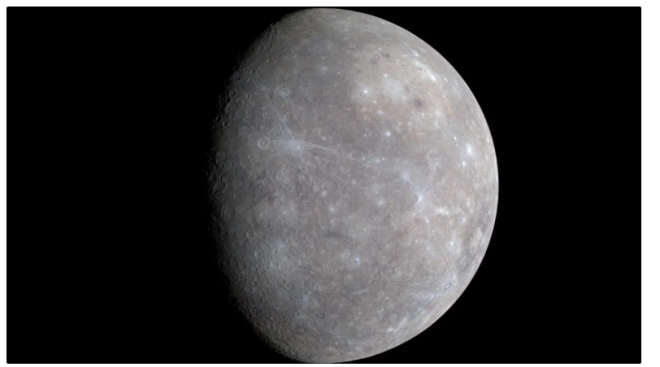

Mercury is the closest planet to the Sun from the perspective of NASA’s Messenger probe.
- Discovery: It was known to the ancient Greeks and can be seen in the sky with the naked eye.
- Naming: Mercury, derived from the name of the messenger god in Roman mythology
- Diameter: 4878 km
- Year: 88 Earth days
- Day: 58.6 Earth days
- Number of moons: zero
Mercury is the closest world to the sun and the smallest planet in the solar system. This planet is only slightly larger than the Earth’s moon and completes its orbit around the sun in 88 days.
The temperature difference between the day and night of Mercury is significant. The temperature of Mercury during the day reaches 450 degrees Celsius, which is enough to melt lead. During the night, the temperature drops to minus 180 degrees Celsius. Mercury’s atmosphere is very thin and contains elements such as oxygen, sodium, hydrogen, helium, and potassium. Since this weak atmosphere cannot prevent meteorite collisions, Mercury’s surface is full of impact craters, just like Earth’s moon.
During its five-year mission, NASA’s MESSENGER probe made interesting findings about Mercury that defied astronomers’ expectations. One of these findings was the discovery of water ice and frozen biological compounds in the north pole of Mercury, as well as the significant role of volcanic activity in the formation of the planet’s surface.
Venus


This image of Venus was captured in 2020 by NASA’s Mariner 10 probe.
- Discovery: It was known to the ancient Greeks and can be seen with the naked eye.
- Naming: Venus, derived from the name of the goddess of love and beauty in Roman mythology
- Diameter: 12,104 km
- Year: 225 Earth days
- Day: 241 Earth days
- Number of moons: zero
Venus is the second planet from the sun and the hottest planet in the solar system. The thick atmosphere of Venus is composed of compounds such as sulfuric acid clouds. Venus can be considered as one of the clear examples of the greenhouse effect.
The average surface temperature of Venus reaches 465 degrees Celsius and its surface pressure is 92 bar (9200 kilopascals), which can disintegrate a human being. Strangest of all, Venus rotates slowly and rotates against the direction of other planets, i.e. from east to west.
Venus is sometimes called Earth’s twin because the planet is close in size to Earth and, based on radar images, has numerous mountains and volcanoes. But in reality, Earth and Venus have many differences from each other.
Since Venus is the brightest object in the night sky after the moon, the Greeks thought that they were two different objects; Hesperus as a night star and Eospherus as a morning star. This very brightness is why Venus is sometimes mistaken for a UFO.
planet Earth


One of the most accurate pictures of the Earth. This composite image is the result of images recorded by the Processing Infrared/Visible Image Radiometer (VIIRS) of the Suomi NPP satellite.
- Name: Earth is derived from the German word “Die Erde” which means earth.
- Diameter: 12,760 km
- Year: 365.24 days
- Day: 23 hours and 56 minutes
- Number of moons: 1
Earth, our home, is the third planet from the Sun. Earth is a blue world with two-thirds of it covered by water. Earth’s atmosphere is rich in nitrogen and oxygen, making it the only life-friendly world we know.
The earth rotates at a speed of 467 meters per second. But this speed is slightly higher in the equator. The speed of the earth’s rotation around the sun reaches 29 km/s. Earth is also the largest rocky planet in the solar system and has one moon. According to scientists, an object hit the earth early in its formation and a piece of it was thrown into the sky and thus the moon was formed.
planet Mars


A mosaic image of the Vals Marineris hemisphere of Mars. This image is the result of combining 102 Viking orbiter images.
- Discovery: It was known to the ancient Greeks and can be seen with the naked eye.
- Name: Mars, derived from the name of the god of war in Roman mythology
- Diameter: 6787 km
- Year: 687 Earth days
- Day: 24 hours and 37 minutes
- Number of moons: 2
Mars is the fourth planet from the Sun. This desert-like and cold planet is covered with iron oxide dust and therefore appears red. Mars has similarities with Earth. It is primarily rocky like Earth, has mountains and valleys, and has a storm system like Earth’s, ranging from small tornado-like ovens to dust storms that cover the entire planet.
Scientific evidence shows that Mars was a warmer and wetter world billions of years ago, and probably had rivers and maybe oceans flowing in it. Although the Martian atmosphere is too thin for surface liquid water to flow, wetter Martian remnants exist today. Martian ice sheets the size of the state of California are located under the surface of Mars, and on the other hand, both poles of Mars have water ice covers.
According to scientists, ancient Mars had the necessary conditions to support life such as bacteria and other microbes. They hope to find signs of this past life and possibly present life forms. This hypothesis became the basis for launching several missions to Mars; So that today the red planet is one of the most familiar and most explored objects in the solar system.
Jupiter


An extraordinary image of Jupiter captured by the Hubble Space Telescope on August 25, 2020.
- Discovery: It was known to the ancient Greeks and can be seen with the naked eye.
- Naming: Jupiter, derived from the name of the god of gods in Roman mythology
- Diameter: 139,822 km
- Year: 11.9 Earth years
- Day: 9.8 Earth hours
- Number of moons: 95
Jupiter is the fifth planet from the sun and the largest planet in the solar system. This gas giant has twice the mass of all other planets in the solar system.
Jupiter’s swirling clouds are colorful due to the combination of a variety of materials such as ammonia ice, ammonium hydrosulfide crystals, and water ice and vapor. One of Jupiter’s most famous features in its swirling clouds is the Great Red Spot, which is more than 16,000 kilometers in diameter and is so large that it can swallow almost three Earths.
Jupiter also has the strongest magnetic field and 95 moons, the most famous of which are Ganymede, Io, Callisto, and Europa, also known as the Galilean moons.
Saturn


The Hubble Space Telescope captured this image of Saturn during the Northern Hemisphere summer on July 4, 2020.
- Discovery: It was known to the ancient Greeks and can be seen in the night sky with the naked eye.
- Naming: Saturn, derived from the name of the god of agriculture in Roman mythology
- Diameter: 120,500 km
- Year: 29.5 Earth years
- Day: approximately 10.5 hours by land
- Number of moons: 145 moons
Saturn, the sixth planet from the Sun, is famous for its huge and bright ring system. Although Saturn is not the only ringed planet in the solar system. When Galileo first studied Saturn in the early 1600s, he thought it was a three-part mass: a planet and two large moons on either side. He didn’t know he was seeing a ringed planet. More than 40 years later, Christian Huygens proved the existence of Saturn’s rings.
Like Jupiter, Saturn is a gas giant and the least dense planet in the solar system. This planet also has a large number of moons, according to the latest statistics, their number reaches 145. With this number of moons, Saturn is considered the king of the solar system’s moons. Enceladus is one of Saturn’s moons covered with an icy ocean, which astronomers say could be a promising target for extraterrestrial life.
Saturn’s rings are composed mostly of ice and rock, and scientists are still unsure how they formed.
Uranus
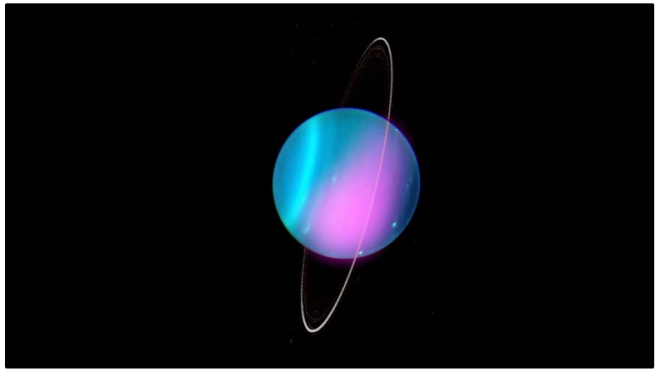

Image of Uranus captured by NASA’s Chandra X-ray Observatory.
- Discovery: 1781 by William Herschel (before this date people thought Uranus was a star).
- Naming: the embodiment of heaven and the name of one of the gods in Greek mythology
- Diameter: 51,120 km
- Year: 84 Earth years
- Day: 18 hours on land
- Number of moons: 27
The planet Uranus, the seventh planet from the sun, has strange and unique features. The clouds of Uranus are composed of hydrogen sulfide, which is the same chemical that causes eggs to rot and smell bad. In the second degree, like Venus, Uranus rotates from east to west, but unlike Venus or any other planet, its equator is perpendicular to its orbit and it can be said to rotate sideways.
According to astronomers, a mass twice the size of Earth collided with Uranus about 4 billion years ago and caused Uranus’ extreme axial deviation. This deviation leads to marginal seasons with a duration of at least 20 years, so that sunlight shines on one pole of Uranus for 84 years.
It seems that the said collision transferred some of the rock and ice of Uranus into its orbit and these rocks and ice later formed the moons of Uranus. Methane in the atmosphere of Uranus is the main reason for its blue-green color. Uranus has 13 sets of rings.
The planet Uranus also holds the record for the coldest temperature recorded in the solar system, minus 224.2 degrees Celsius. The average temperature of Uranus reaches minus 195 degrees Celsius.
The planet Neptune
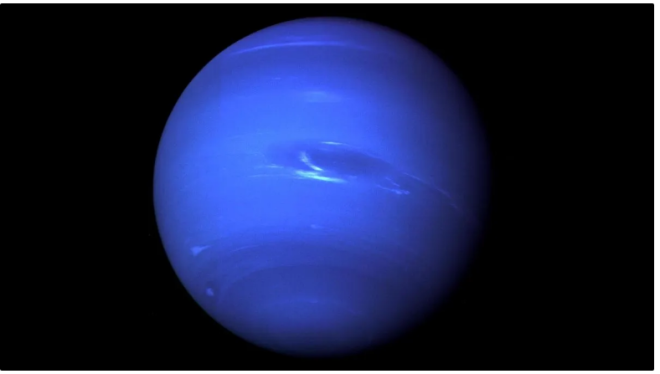

Neptune is the planet with the fastest winds in the solar system.
- Discovery: 1846
- Naming: Neptune, derived from the name of the god of water and sea in Roman mythology
- Diameter: 49,530 km
- Year: 165 Earth years
- Day: 19 hours on land
- Number of moons: 14
Neptune is the eighth and farthest planet from the Sun. The average temperature of Neptune in the upper part of the clouds reaches minus 210 degrees Celsius. This planet is about the same size as Uranus and is known for its strong supersonic winds.
Neptune was the first planet to be discovered using mathematics. German astronomer Johann Galle used mathematical calculations to find Neptune with a telescope.
Neptune is about 17 times heavier than Earth and has a rocky core. The main composition of Neptune is water, methane, and ammonia, which surround this rocky core. The speed of Neptune’s winds reaches 2000 km/h. This planet also has 14 moons.
asteroid belt
The asteroid belt is located between Mars and Jupiter. According to NASA estimates, there are between 1.1 and 1.9 million asteroids in the main asteroid belt that are larger than one kilometer in diameter. The dwarf planet Ceres with a diameter of approximately 950 km is located in this part of the solar system. Several asteroids have orbits that occasionally collide with Earth and other inner planets.
Kuiper belt
Astronomers have long suspected the existence of a band of icy material known as the Kuiper Belt, which lies beyond the orbit of Neptune at a distance of 30 to 55 times the distance from the Earth to the Sun. Since the 20th century, more than a thousand crimes have been discovered in this belt. According to scientists’ estimates, the Kuiper Belt probably hosts hundreds of thousands of icy bodies larger than 100 km, as well as almost a trillion comets.
Pluto, which today belongs to the group of dwarf planets, is located in the Kuiper belt. Of course, Pluto is not the only one, and Makimaki, Haumea, Eris, and Quavar are among the other known non-Neptunian objects from the group of dwarf planets. Aracut (Altima Tully) is also a binary asteroid located in the Kuiper Belt that was visited by the New Horizons probe in 2019.
Pluto


A panoramic view of the dwarf planet Pluto
- Discovered: 1930 by Clyde Tamba
- Naming: Pluto or Pluton derived from the name of the god of the underworld in Roman mythology
- Diameter: 2301 km
- Year: 248 Earth years
- Day: 6.4 Earth days
- Number of moons: 5
The dwarf planet Pluto was once considered the ninth planet, but since 2006 it has been classified as a dwarf planet. The reason for this problem was the non-compliance with the existing criteria in the definition of the planet. According to the definition of the International Astronomical Union, a planet is a celestial body that firstly orbits the Sun, secondly has enough gravity to become a spherical or almost spherical body, and thirdly clears the vicinity of its orbit. be Pluto did not fit the third criterion of logic and therefore was removed from the group of planets.
Pluto has a highly elliptical orbit so it sometimes even interferes with Neptune’s orbit. On the other hand, Pluto’s orbit is not in the same plane as other planets, but it revolves around the Sun at an angle of 17.1 degrees above or below them.
Because of this strange orbit, Pluto was considered the eighth planet from the Sun from 1979 to early 1999, but on February 11, 1999, when it crossed the path of Neptune, it again became the most distant planet in the Solar System, until it was officially removed from the Sun in 2006. The group of planets is out.
Smaller than Earth’s moon, Pluto is a cold, rocky world with a thin atmosphere. On July 14, 2015, the New Horizons probe performed several low-altitude flybys around Pluto, presenting a new view of the dwarf planet to the scientific world that defied many expectations.
Pluto is actually a very active ice world, covered in glaciers, ice mountains, icebergs, and possibly even glaciers that spew ice made of water, methane, or ammonia.
The ninth planet


According to estimates, the hypothetical ninth planet has approximately 10 times the mass of Earth.
In 2016, researchers raised the possibility of the ninth planet . This object, also known as Planet X, is estimated to have 10 times the mass of Earth and orbits the star of our system at a distance between 300 and 1,000 times the distance between Earth and the Sun. In fact, this planet’s year may last between 10,000 and 20,000 Earth years. Scientists have not been able to observe the ninth planet so far and have guessed its existence based on its gravitational effects on other objects in the Kuiper belt.
According to some hypotheses, the hypothetical ninth planet could be a primordial black hole that formed shortly after the Big Bang and was trapped by the solar system. Unlike black holes that result from the collapse of massive stars, primordial black holes were formed by gravitational perturbations less than a second after the Big Bang and may be very small (as little as five centimeters in diameter), making them difficult to detect.
Astronomers have not yet reached a clear conclusion regarding the ninth planet. Based on a 2022 survey by the ACT telescope in Chile, there are thousands of candidate sources for the planet, but none have yet been confirmed.
Edge of the solar system
The heliosphere surrounds the solar system like a bubble and its boundary is called the heliopass.
By passing through the Kuiper belt, we reach the edge of the solar system or the Heliopass. The heliosphere is a vast, tear-shaped region of space with a large amount of charged particles received from the sun. According to many astronomers, the boundary of the heliosphere, which is called the heliopass, is approximately 15 billion kilometers from the sun.
The Oort cloud is located after the Kuiper belt at a distance of 2,000 to 2,500 AU from the Sun, and the distance of its outer edge from the Sun is estimated to be between 10,000 and 100,000 AU. As mentioned in the previous sections, one astronomical unit is approximately equal to 150 million kilometers. The Everett Cloud is home to billions or perhaps trillions of particles.
The largest planets in the solar system


Jupiter compared to other planets
Jupiter is by far the largest planet in the solar system, so if you add the mass of all the planets in the solar system together, Jupiter will still be two and a half times more. Compared to Earth, Jupiter is 318 times the size of Earth. The radius of this planet reaches 69,911 km or one-tenth of the sun. Saturn is the second largest planet in the solar system. Saturn has 95 times the mass of Earth; however, it is the least dense planet in the solar system, so that it can float on water.
Discoveries and travels of the solar system
According to NASA, more than 254 probes have left Earth’s orbit so far. A large part of these spacecrafts and probes were dedicated to the exploration of the solar system.
Parker probe is the only spacecraft that managed to reach the closest distance to the Sun and will break this record in the coming years. The probe will release information about the solar radiation, surface, corona, and solar wind.
Famous probes such as NASA’s MESSENGER, Mariner 10, and Beppy Columbo have visited Mercury and revealed valuable information such as the discovery of water ice and the thin atmosphere of Mercury.
In general, 46 probes have visited Venus so far, the most successful of which are the Venus Express, Mariner 10, and Magellan missions. These probes released information about the atmosphere of Venus and its possible volcanic activity.
There are many satellites in the earth’s orbit whose task is to check weather and atmospheric conditions. Also, the International Space Station is the largest man-made structure in space, and astronauts are engaged in research work there.
In the last 60 years, six lunar landers have landed on the surface of the moon, the first of which was the Apollo 11 mission. Also, in recent years, orbiters were placed in the orbit of the moon, whose most important achievement was finding water ice around the poles of the moon. Space agencies aim to land on the surface of the Moon again in the coming years and use the Earth’s moon as a research base.


Apollo 11, the first human landing on another world.
Mars is the most explored planet in the solar system, which has been assigned more than 50 exploration missions. The most famous Mars missions include the Curiosity rover, Perseverance, and the MRO orbiter. Each of the Mars rovers and probes is investigating a certain area and so far they have published important and valuable data such as the discovery of water ice, polar ice cover, and methane on Mars. In the not-too-distant future, human explorations will be added to this collection.
Among the outer planets of the solar system, Jupiter and Saturn are two of the most explored examples. So far, eight spacecraft have been sent specifically to visit Jupiter, and two other probes have performed low-altitude flybys of the planet. The Juno probe is still in Jupiter’s orbit and has provided valuable information about Jupiter’s atmosphere and its important moons.


Voyager 2, is the first and so far the only probe to visit the planets Uranus and Neptune.
Cassini is the most famous probe that visited Saturn, and in addition to recording beautiful images of Saturn and sending information about its atmospheric conditions and rings, it investigated two important moons of Saturn, Titan and Enceladus. Two of Cassini’s most important discoveries in visiting these moons were the discovery of methane lakes on Titan and glaciers and ice oceans on Enceladus.
The two famous probes Voyager 1 and 2 successfully visited the outer planets of the outer solar system, including Jupiter, Saturn, Uranus, and Neptune. Voyager 2 is the only probe that visited Uranus and Neptune up close.
New Horizons is the only probe to visit the dwarf planet Pluto, sending back important information about surface conditions, moons, and other Kuiper Belt objects.
In addition to the probes that visited the planets of the solar system, a series of missions were dedicated to the study of objects in the asteroid belt. Also, the Hubble and James Webb telescopes have sent important images and data from the solar system.
Conclusion
The solar system is a collection of planets, moons, asteroids, and comets around the sun. The planets of the solar system are divided into two groups: rocky and gaseous planets. Earth is a rocky planet and the only planet known to host life in the entire universe. So far, many probes have been sent to different planets of the solar system. Meanwhile, Mars is considered the most explored and familiar planet of the solar system, which mankind has made the most efforts to investigate. Today, humans are carrying out missions and building new probes to investigate the potential of life on the planets and moons of the solar system, and in this way, they will get help from ground and space telescopes.


You may like


Why is it still difficult to land on the moon?
This year, the private company Spacel and the Indian Space Organization both met tragic ends when they tried to land their spacecraft on the surface of the moon. Despite the astonishing leaps made in recent decades in computing, artificial intelligence and other technologies, it seems that landing on the moon should be easier now; But recent setbacks show that we still have a long way to go with safe and trouble-free landings on the surface of Earth’s only moon.
50 years after sending the first man to the surface of the moon, the question arises as to why safely landing a spacecraft on Earth’s nearest cosmic neighbor is still a difficult task for space agencies and private space companies. Stay with Zoomit to check the answer to this question.
Why is the lunar landing associated with 15 minutes of fear?
Despite the complexities of any space mission, sending an object from Earth into orbit around the moon today is easy. Christopher Riley, the director of the documentary film In the Shadow of the Moon produced in 2007 and the author of the book Where We Stood (2019), both of which are about the history of the Apollo 11 mission, explained the reasons for the difficulty of landing on the moon in an interview with Digital Trends. is According to him: “Today, the paths between the Earth and the Moon are well known, and it is easy to predict them and fly inside them.”

Chandrayaan 2 mission launch
However, the real challenge is getting the spacecraft out of orbit and landing it on the lunar surface; Because there is a delay in the communication between the Earth and the Moon, and the people in the control room who are present on the Earth cannot manually control the spacecraft in order to land it safely on the Moon. As a result, the spacecraft must descend automatically, and to do so, it will fire its descent engines to slow its speed from thousands of kilometers per hour to about one meter per second, in order to make a safe landing on the lunar surface.
For this reason, the director of the Indian Space Research Organization (ISRO), who was trying to land the Vikram lander last month, described the final descent of the spacecraft as “frightening 15 minutes”; Because as soon as the spacecraft enters the landing stage, the control of its status is out of the hands of the mission control members. They can only watch the spacecraft land and hope that everything goes according to plan, that hundreds of commands are executed correctly, and that the automatic landing systems gently bring the spacecraft closer to the surface of the moon.
The Great Unknown: The Landing Surface
One of the biggest challenges in the final descent phase is identifying the type of landing site. Despite the availability of instruments such as the Lunar Reconnaissance Orbiter (LRO) that can capture amazing views of the lunar surface, it is still difficult to know what kind of surface the spacecraft will encounter when it lands on the moon.

Left: Breshit crash site. Right: The ratio of the before and after images highlights the occurrence of minor changes in surface brightness.
Leonard David, author of Moon Fever: The New Space Race (2019) and veteran space reporter, says:
The Lunar Reconnaissance Orbiter is a very valuable asset that has performed really well over the years; But when you get a few meters above the surface of the moon, complications appear that cannot be seen even with the very powerful LRO camera.
Even today, despite the imaging data available, “some landing sites still have unknown remains,” Riley says. He notes that the Apollo 11 mission included an advantage that today’s unmanned landers lack, which is the presence of an astronaut’s observer’s eyes that can closely observe the surface of the spacecraft’s landing site. As you probably know, in the mission that led to the landing of the first man on the surface of the moon, the Eagle computer was guiding the spacecraft to a place full of boulders; But to avoid hitting the rocky surface of the moon, Armstrong took control of the spacecraft himself and landed it on a flat surface.
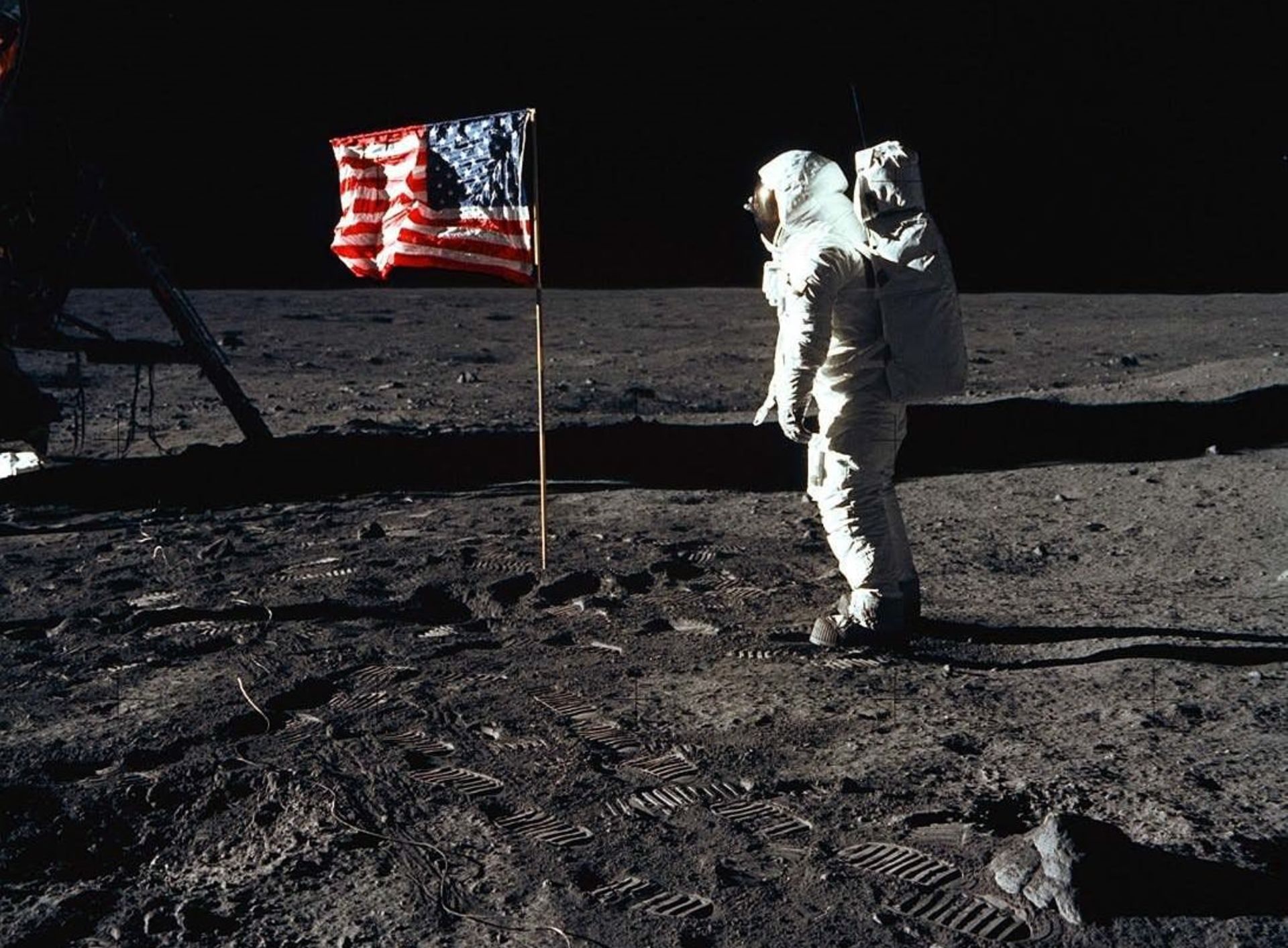
The uneven surface of the landing site had caused many problems in previous lunar missions such as Apollo 15. In this mission, the astronauts were told that as soon as the spacecraft touched the surface of the moon, they should turn off the engines to prevent dust from being sucked in and the risk of a return explosion. But the Apollo 15 spacecraft landed in a crater, and because of this, one of its legs came into contact with the surface earlier than the others. When the crew shut down the engines, the spacecraft, moving at a speed of 1.2 meters per second, experienced a hard landing. The lander landed at an oblique angle, and although it eventually landed safely, it nearly overturned, causing a fatal disaster.
- Half a century after Apollo 11; How did the great human leap happen?
- dust storms; The nightmare of space missions to the moon
The difficult landing of Apollo 15 introduced another complicating factor in lunar landings: lunar dust. The Earth’s moon is covered with dust that is thrown into the air by any movement and sticks to everything it comes in contact with. As the spacecraft approaches the surface of the moon, huge plumes of dust are kicked up that limit the field of view and endanger the spacecraft’s electronics and other systems. We still do not have a solution to deal with the dust problem.
An achievement that has been achieved before
Another reason why the moon landing remains a challenge is that gaining public support for lunar projects seems difficult. Referring to Neil Armstrong and Buzz Aldrin, the two astronauts who walked on the moon during the Apollo 11 mission, David says, “We convinced ourselves that we had sent Neil and Buzz [to the surface of the moon]; “As a result, when it comes to lunar missions, people may say we’ve been there before and we’ve had this success.”

But in reality, our understanding of the moon is still very little, especially in relation to long-term missions. Now, with a 50-year gap between the Apollo missions and NASA’s upcoming Artemis project, the knowledge gained has been lost as engineers and specialists retire. David says:
We need to recover our ability to travel into deep space. We haven’t gone beyond near-Earth orbit since Apollo 17 and since 1972. NASA is no longer the same organization that put men on the moon, and there is a whole new generation of mission operators.
The importance of redundancy
As the first private spacecraft entered into orbit around the moon, the Space project was of considerable importance; But its failure to land smoothly on the surface of the moon made the achievement of landing on the surface of the moon still remain in the hands of governments. However, we can expect more private companies, such as Jeff Bezos ‘ Blue Origin, which is developing its lunar lander, to target the moon in the future. According to Elon Musk, even the giant SpaceX Starship spacecraft, which is being built with the ultimate goal of sending a human mission to Mars , can also land on the moon.
According to David, private companies’ participation in lunar landings has advantages such as increased innovation. However, companies are under pressure to save money, and this can lead to a lack of redundancy and support systems that are essential in the event of errors and malfunctions. Lunar rovers typically include two or even three layers of support systems. David is concerned that private companies will be encouraged to eliminate these redundancies in order to cut costs and save money.
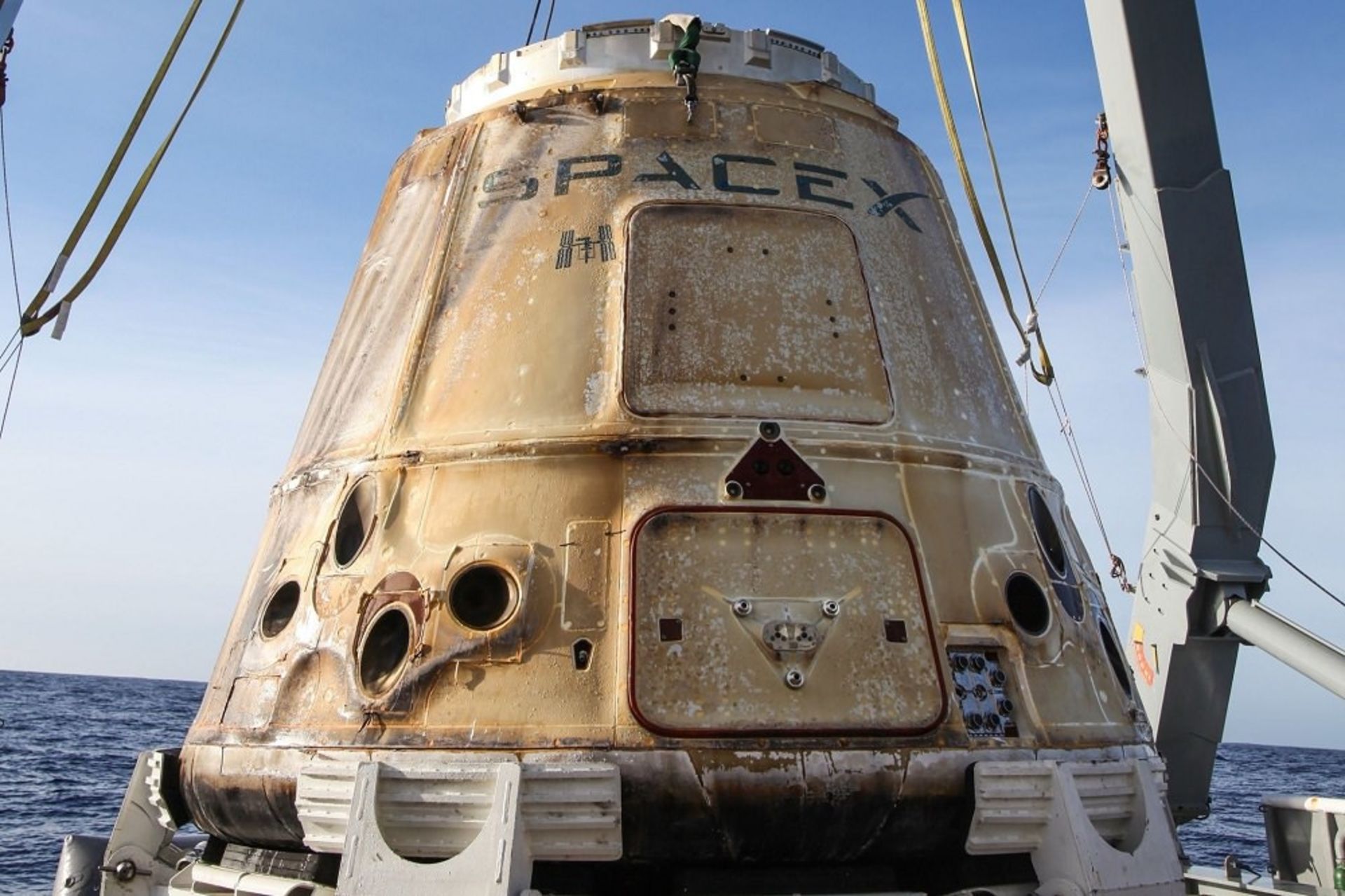
Crew Dragon SpaceX passenger capsule
“We saw Elon Musk’s Dragon capsule catch fire after a failed test on the stand,” says David, referring to the explosion of the SpaceX spacecraft in April, which had no crew on board. “This accident was kind of a wake-up call about how unpredictable the performance of spacecraft can be.” David compared the Crew Dragon incident to the Apollo 1 disaster, which killed three NASA astronauts during a test launch in 1967.
Another problem related to the lack of redundancy systems is the lack of information needed when an error occurs. As for the recent landings, it seems that the SpaceX crash was caused by human error; however, it is not clear what caused the failure of Chandrayaan 2 in the calm landing, and it is possible that without the necessary systems to record and send information to the lander, we will never find out the main reason for the failure of this mission. Without the required data, it becomes much more difficult to prevent problems from reoccurring in the future.
The future of lunar landings
Currently, many projects are underway to facilitate future moon landings. Ultimately, we need to be able to build the necessary infrastructure for a long-term stay on the moon.
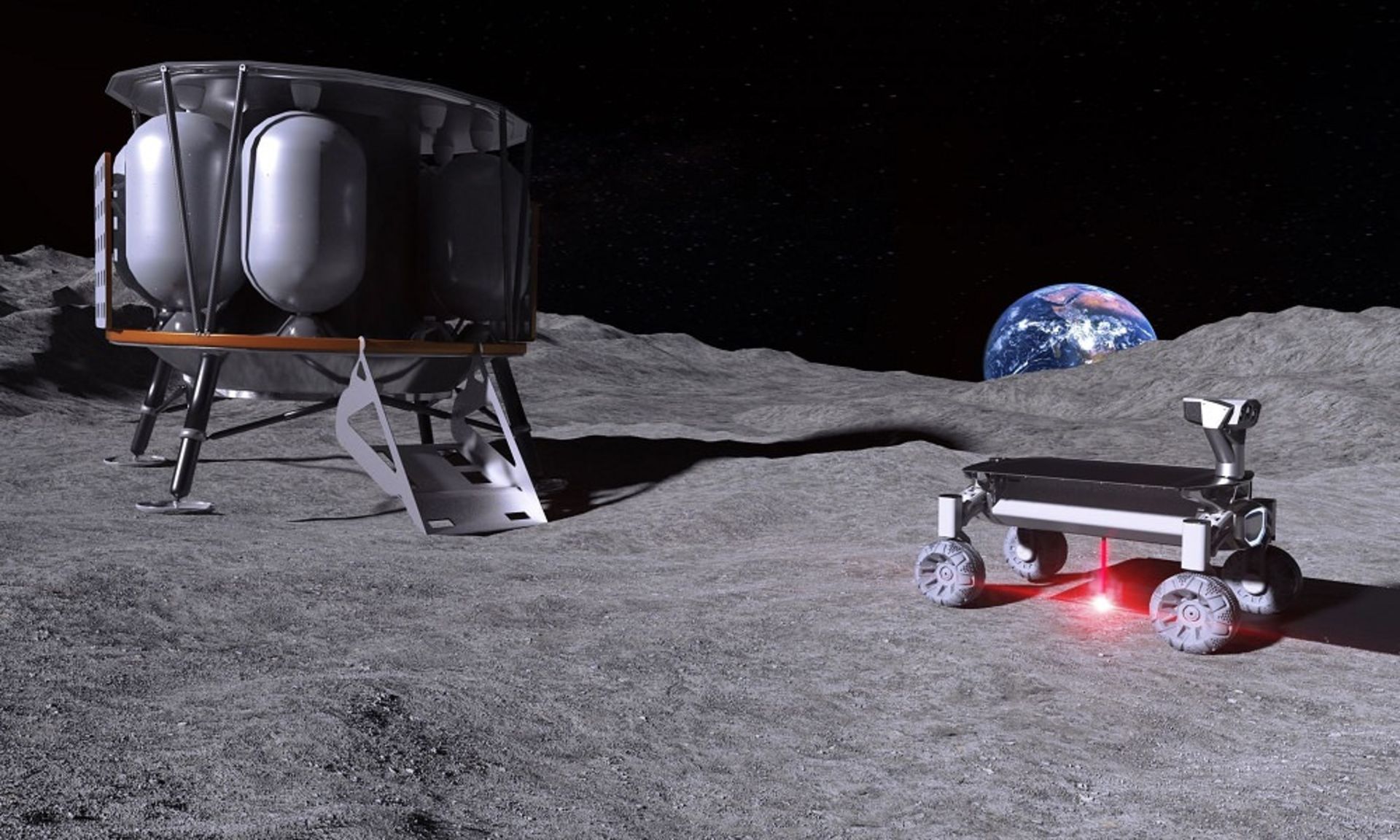
Conceptual design of Moonrise technology on the moon. On the left side is the Alina lunar module, and on the right side, the lunar rover equipped with Moonrise technology melts the lunar soil with the help of a laser.
If we can make long-term stays on the moon possible, or even build a permanent base there, landing spacecraft on the lunar surface will be much easier. By constructing the landing sites, a flat, safe, and free surface of unknown debris can be created for the landing of surface occupants. For example, researchers are currently conducting research at NASA’s Kennedy Space Center to investigate the feasibility of using microwaves to melt the lunar soil (regolith) and turn it into a hard foundation so that it can be used as a landing and launch site. The European Space Agency is also investigating how to use 3D printing to create landing sites and other infrastructure on the moon.
Read more: Europa Clipper, NASA’s flagship probe was launched
Other ideas include the use of lidar remote sensing systems, which are similar to radar systems; But instead of radio waves, it uses lasers to land the spacecraft. Lidar technology provides more accurate readings and uses a network of GPS satellites to help guide the spacecraft during landing.
The problem of public support
As important as technology is, public interest and support are essential to the success of the lunar landing program. “Apollo had enormous resources that are perhaps only comparable today to China’s space program,” says Riley. “Remember that Apollo carried the best computer imaginable, the human brain.” It goes without saying that there is an element of luck involved in every landing.
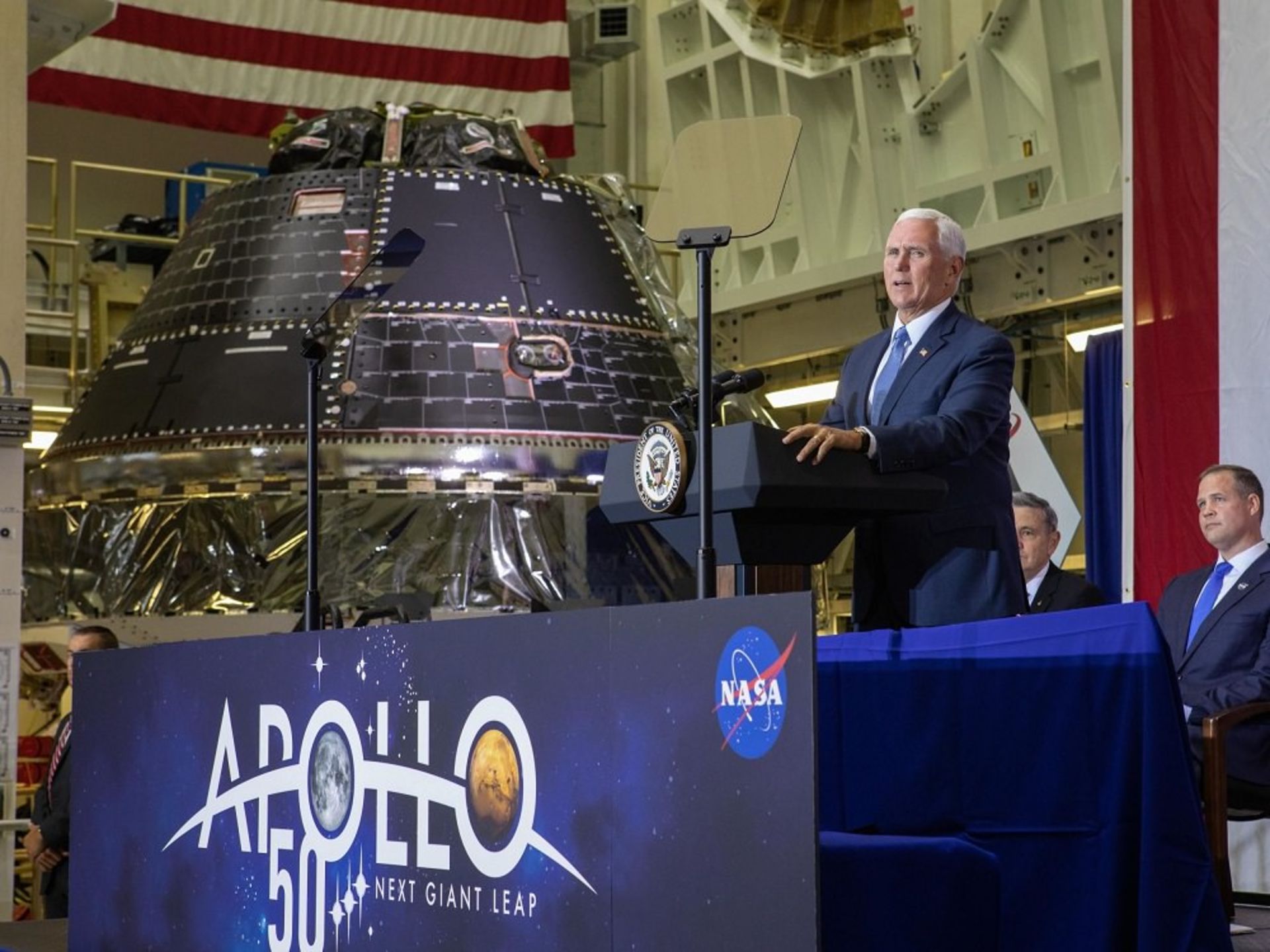
US Vice President Mike Pence speaking at the 50th anniversary of the Apollo 11 mission
Finally, there is the question of what kind of failure is acceptable for people. David says:
I think we have to be serious about the fact that we’re probably going to lose people. There is a serious possibility that the manned lunar lander will crash and kill the astronauts inside. The American people continued to support NASA despite the failures and bad luck of the Apollo program, But at that time there was a lot of pressure to compete with the Soviet Union. Without the bipolar atmosphere of the Cold War and the space race, would people still support missions with human lives in between?


Europa Clipper, NASA’s flagship probe was launched
After years of waiting, NASA’s Europa Clipper probe was finally launched on Monday at 7:36 p.m. Iran time from the Kennedy Space Center on top of SpaceX’s Falcon Heavy rocket and began a major astrobiology mission to Europa, the potentially habitable moon of Jupiter.
As SpaceX’s massive rocket powered by 27 powerful Merlin engines lifted off from pad 39A, NASA live broadcast reporter Dron Neal said, “The launch of Falcon Heavy with Europa Clipper will reveal the secrets of the vast ocean beneath the icy crust of Europa, Jupiter’s moon. It has been hidden, it will reveal.”
The engines of the two side boosters of the Falcon Heavy were shut down and separated from the central booster approximately three minutes after the flight. The central booster continued to fly for another minute, and then in the fourth minute of the launch, the separation of the upper stage from the first stage was confirmed. Finally, 58 minutes later, Europa Clipper was injected into interplanetary orbit as scheduled. A few minutes later, the mission team made contact with the probe, and people in the control room cheered and applauded.
Falcon Heavy’s unique launch
The launch of NASA’s new probe was delayed due to some mishaps. NASA and SpaceX initially planned to launch the Europa Clipper mission on Thursday, October 10; But with powerful Hurricane Milton hitting Florida’s Gulf Coast on Wednesday evening, a delay in the launch became inevitable. NASA shut down Kennedy Space Center to deal with the storm, and Europa Clipper was placed inside SpaceX’s hangar near Launch Pad 39A.
The recent launch was Falcon Heavy’s 11th flight overall and its second interplanetary mission. Also, this was the first flight of the Falcon Heavy, when all three boosters of the first stage of the rocket were deployed.
Typically, the Falcon Heavy and Falcon 9 first-stage boosters store enough fuel to perform landing maneuvers for recovery and reuse in the future; But Europa Clipper needed all the power that Falcon Heavy could provide in order to make it on its way to the Jupiter system.
A long way to the launch pad
In late 2015, the US Congress directed NASA to launch Europa Clipper using the Space Launch System (SLS), NASA’s massive rocket. SLS was still under construction at the time and was several years away from reaching the launch pad. The delay in completing the construction of this powerful rocket and NASA’s need to assign at least the first three versions of SLS to the Artemis lunar mission caused the Europa Clipper launch date to be in an aura of uncertainty.
In the 2021 House budget draft for NASA, the agency was directed to launch Europa Clipper by 2025 and, if possible, with SLS. However, due to the unavailability of the Space Launch System, NASA had to go to SpaceX’s Falcon Heavy. This decision was not without cost. As the most powerful rocket ever used in an operational mission, SLS can send Europa Clipper directly to the Jupiter system in less than three years.
Europa Clipper will use the gravitational assistance of Mars and Earth on its way to the Jupiter system
Now, even in Falcon Heavy’s fully disposable mode, the Clipper’s trip to Europe takes almost twice as long. The probe should make a flyby of Mars in February 2025 and a flyby of Earth in December 2026 to gain enough speed to reach its destination in April 2030.
Missile problems were not the only obstacles facing Europa Clipper on its way to the launch pad. For example, the rising costs of this five billion dollar probe forced NASA to cancel the construction of one of the probe’s science instruments. This instrument, named “Identification of Europa’s internal features using a magnetometer” (ICEMAG), was designed to measure Europa’s magnetic field.
Then in May 2024, NASA found that transistors similar to those used in Europa Clipper, which are responsible for regulating the probe’s electricity, were “failing at lower-than-expected radiation doses.” Following this discovery, NASA conducted more tests on the transistors and finally concluded in late August that these components could support the initial mission in the radiation-rich environment around Jupiter.
Ambitious mission to a fascinating moon

NASA/Jet Propulsion Laboratory-Caltech
Europa Clipper is one of NASA’s most exciting and ambitious flagship missions, and it has impressive features. For example, the mission probe is the largest spacecraft NASA has ever built for a planetary mission. Europa Clipper weighed almost 6,000 kg at the time of launch and will be more than 30 meters long (bigger than a basketball court) by opening its huge solar panels in space.
Clipper’s Europa destination is also a prominent location: Europa, one of Jupiter’s four Galilean moons. The moon is covered with an icy outer shell, which scientists believe hides a vast ocean of salty liquid water. For this reason, Europa is considered one of the best places in the solar system to support alien life.
In early 2012, studies began to look for potential plumes of water rising from Europa’s surface. Some researchers theorize that those water columns and vents from which the columns protrude may contain evidence of life living beneath the moon’s icy crust. However, NASA scientists have made it clear that Europa Clipper is not looking for extraterrestrial life in Europa; Rather, this probe will only investigate the potential of the submoon water environment to support life.
“If there’s life on Europa, it’s going to be under the ocean,” Bonnie Buratti, senior Europa Clipper scientist at NASA’s Jet Propulsion Laboratory, said in September. As a result, we cannot see it.” “We will be looking for organic chemicals that are prerequisites for life on the surface of the moon,” Borrati added. There are things we can observe; such as DNA or RNA; But we don’t expect to see them. As a result, [the probe] is only looking for habitable environments and evidence for the ingredients of life, rather than life itself.”
NASA scientists have made it clear that Europa Clipper is not looking for extraterrestrial life in Europa
Europa Clipper will collect data using a suite of nine scientific instruments, including visible and thermal cameras, several spectrometers, and special equipment to identify Europa’s magnetic environment. As stated on NASA’s Europa Clipper page, the probe will help scientists achieve three main goals:
- Determining the thickness of Europa’s ice sheet and understanding how Europa’s ocean interacts with the lunar surface.
- Investigating the composition of Europa’s ocean to determine whether it has the materials necessary to form and sustain life.
- Studying the formation of Europe’s surface features and discovering signs of recent geological activities; such as the sliding of crustal plates or the discharge of water columns in space.
Europa Clipper also transports Earth’s culture to the Solar System. A piece called “In Praise of Mystery: A Poem for Europe” by Edda Lemon, a famous American poet, is engraved in the artist’s own handwriting on a metal plate. In addition, the probe carries a coin-sized chip that contains the names of 2.6 million inhabitants of planet Earth.
6-year journey

Johns Hopkins University Applied Physics
If all goes according to plan, Europa Clipper will enter Jupiter’s orbit in April 2030. When the probe gets there, it will use up 50-60% of its 2,722 kg of fuel by performing an injection maneuver for 6-8 hours.
The injection maneuver puts Europa Clipper in an elliptical orbit around the gas giant. A series of long maneuvers will then be performed to align the trajectory so that the probe can fly by Europa more than 45 times and study it closely. In fact, Europa Clipper will remain around Jupiter throughout its mission; Because according to the launch environment of Europa, it will be very dangerous for the spacecraft to go around the moon.
If all goes according to plan, Europa Clipper will enter Jupiter’s orbit in April 2030
The first flight over Europe will not take place before the spring of 2031. NASA will use the first pass to make further corrections to Europa Clipper’s trajectory in preparation for the probe’s first science mission. With the start of scientific flybys in May 2031, Europa Clipper will aim its array of sensors towards the far hemisphere from Jupiter and will approach the surface of the moon up to 25 km. The second science campaign will begin two years later, in May 2033, in the Jupiter-facing hemisphere of Europa.
The end of the Europa Clipper mission is set for September 2034. At that time, NASA will crash the spacecraft into Ganymede, another Galilean moon of Jupiter. This disposal strategy was chosen because Ganymede is considered a relatively poor candidate to host life, and the mission team wanted to make sure they did not contaminate potentially life-hosting Europa with terrestrial microbes.
Space
Dark matter and ordinary matter can interact without gravity!
Published
3 weeks agoon
01/10/2024

Preposition: For each; per.
Noun: A topology name.
Noun: which has mass but which does not readily interact with normal matter except through gravitational effects.
Adverb: Beyond all others.
Preposition: For each; per.
Noun: A topology name.
Dark matter and ordinary matter can interact without gravity!
Why is dark matter associated with the adjective “dark”? Is it because it harbors some evil forces of the universe or hidden secrets that scientists don’t want us to know? No, it is not. Such fanciful assumptions may sound appealing to a conspiracy theorist, but they are far from the truth.
Dark matter is called dark because it does not interact with light. So when dark matter and light collide, they pass each other. This is also why scientists have not been able to detect dark matter until now; it does not react to light.
Although it has mass and mass creates gravity, this means that dark matter can interact with normal matter and vice versa. Such interactions are rare, and gravity is the only known force that causes these two forms of matter to interact.
However, a new study suggests that dark matter and ordinary matter interact in ways other than gravity.
If this theory is correct, it shows that our existing models of dark matter are somewhat wrong. In addition, it can lead to the development of new and better tools for the detection of dark matter.
Read more: There is more than one way for planets to be born
A new missing link between dark and ordinary matter
Dark matter is believed to have about five times the mass of normal matter in our universe, which helps hold galaxies together and explains some of the motions of stars that don’t make sense based on the presence of visible matter alone.
For example, one of the strongest lines of evidence for the existence of dark matter is the observation of rotation curves in galaxies, which show that stars at the outer edges of spiral galaxies rotate at rates similar to those near the center. These observations indicate the presence of an invisible mass.
Also, for their study, the researchers studied six ultra-dim dwarf (UFD) galaxies located near the Milky Way. However, in terms of their mass, these galaxies have fewer stars than they should. This means they are mostly made up of dark matter.
According to the researchers, if dark matter and normal matter interact only through gravity, the stars in these UFDs should be denser in the centers and more spread out toward the edges of the galaxies. However, if they interact in other ways, the star distribution looks different.
The authors of the study ran computer simulations to investigate both possibilities. When they tested this for all six ultra-dim dwarf (UFD) galaxies, they found that the distribution of stars was uniform, meaning that the stars were spread evenly across the galaxies.
This was in contrast to what is generally observed for gravitational interactions between dark matter and normal matter.
What causes this interaction?
The results of the simulations showed that gravity is not the only force that can make dark matter and normal matter interact. Such an interaction has never been observed before, and it could change our understanding of dark matter and dark energy.
However, this study has a major limitation. What caused the interaction between the two forms of matter is still a mystery. While the current study provides tantalizing hints of a novel interaction, its exact nature and underlying causes remain unknown. Hopefully, further research will clarify the details of such interactions.
This study was published in The Astrophysical Journal Letters.


Ancient humans survived the last ice age just fine


iPhone 16 Pro Review


Why is the colon cancer increasing in people younger than 50?


Why is it still difficult to land on the moon?


Biography of Geoffrey Hinton; The godfather of artificial intelligence


The Strawberry Project; The OpenAI artificial intelligence model


Everything you need to know about the Windows Blue Screen of Death


Starlink; Everything you need to know about SpaceX Satellite Internet


iOS 18 review: A smart update even without Apple’s intelligence


There is more than one way for planets to be born
Popular
-



 Technology1 year ago
Technology1 year agoWho has checked our Whatsapp profile viewed my Whatsapp August 2023
-



 Technology1 year ago
Technology1 year agoSecond WhatsApp , how to install and download dual WhatsApp August 2023
-



 Technology1 year ago
Technology1 year agoHow to use ChatGPT on Android and iOS
-



 AI2 years ago
AI2 years agoUber replaces human drivers with robots
-



 Technology1 year ago
Technology1 year agoThe best Android tablets 2023, buying guide
-



 Technology1 year ago
Technology1 year agoThe best photography cameras 2023, buying guide and price
-



 Humans2 years ago
Humans2 years agoCell Rover analyzes the inside of cells without destroying them
-



 Technology1 year ago
Technology1 year agoHow to prevent automatic download of applications on Samsung phones










